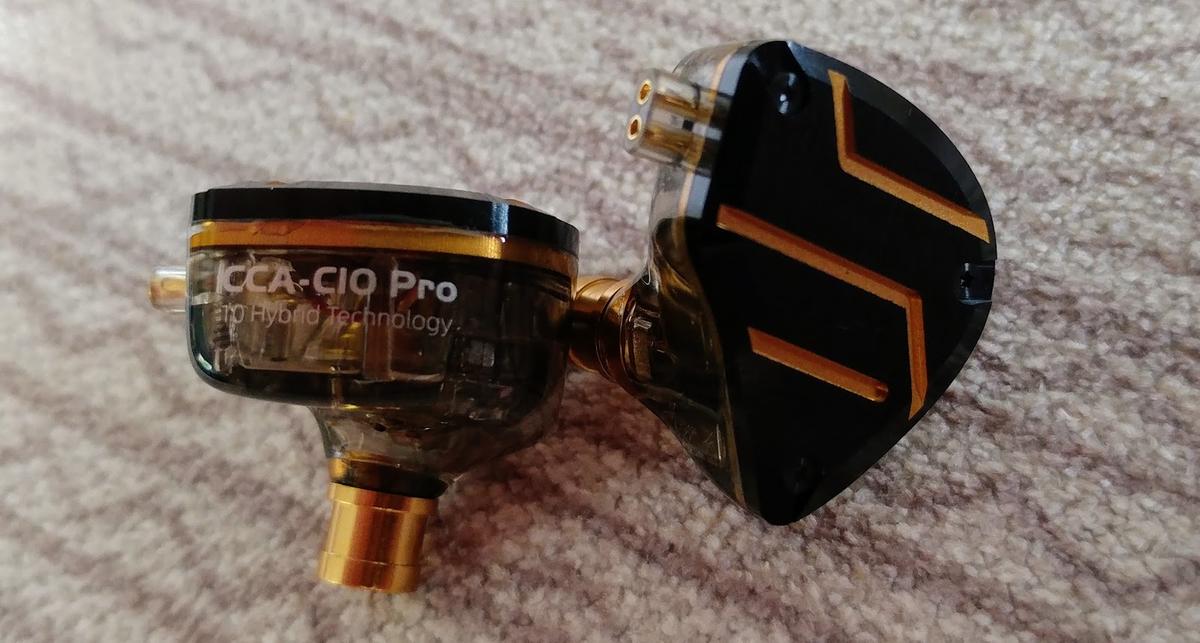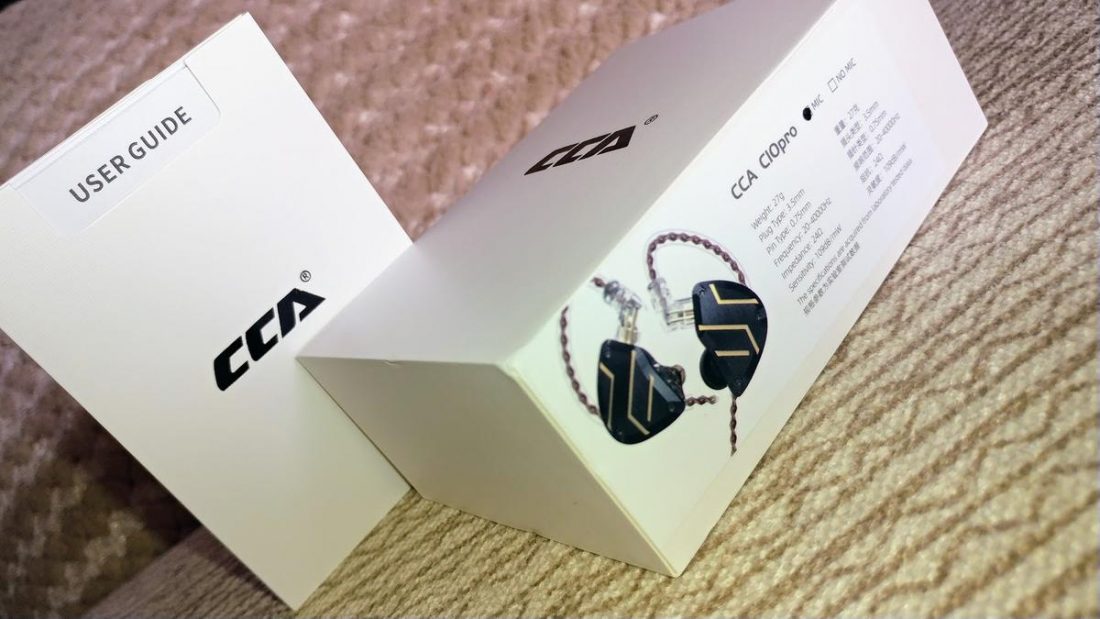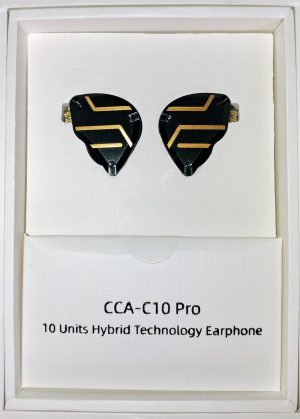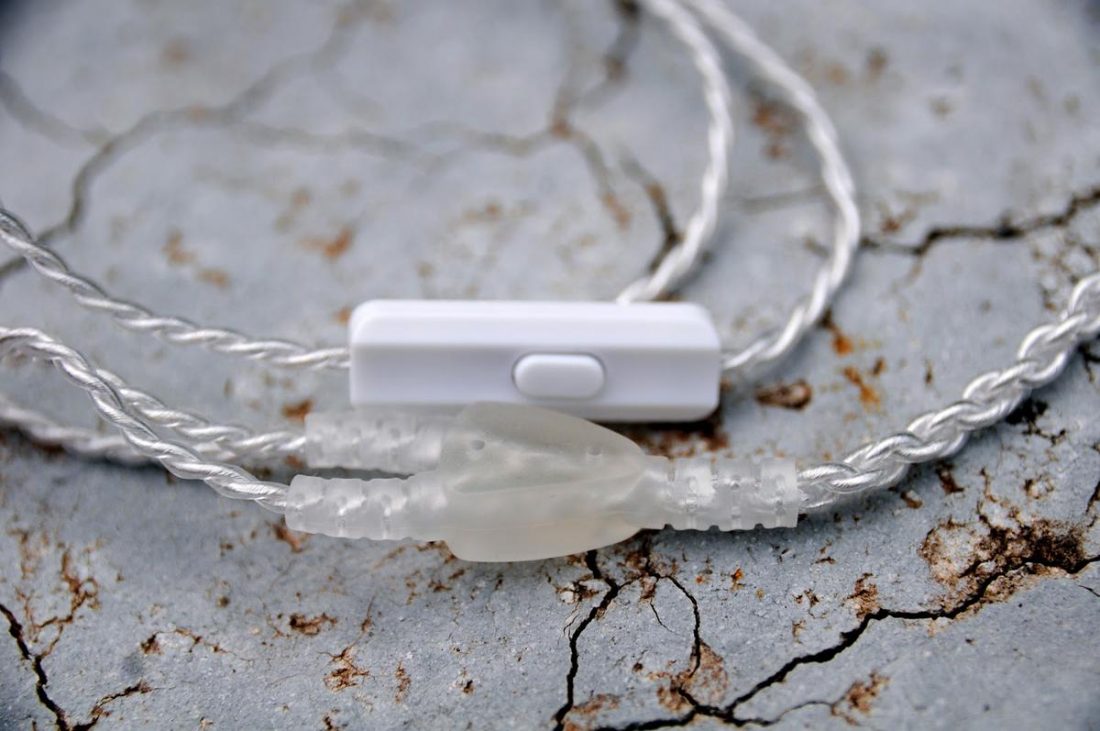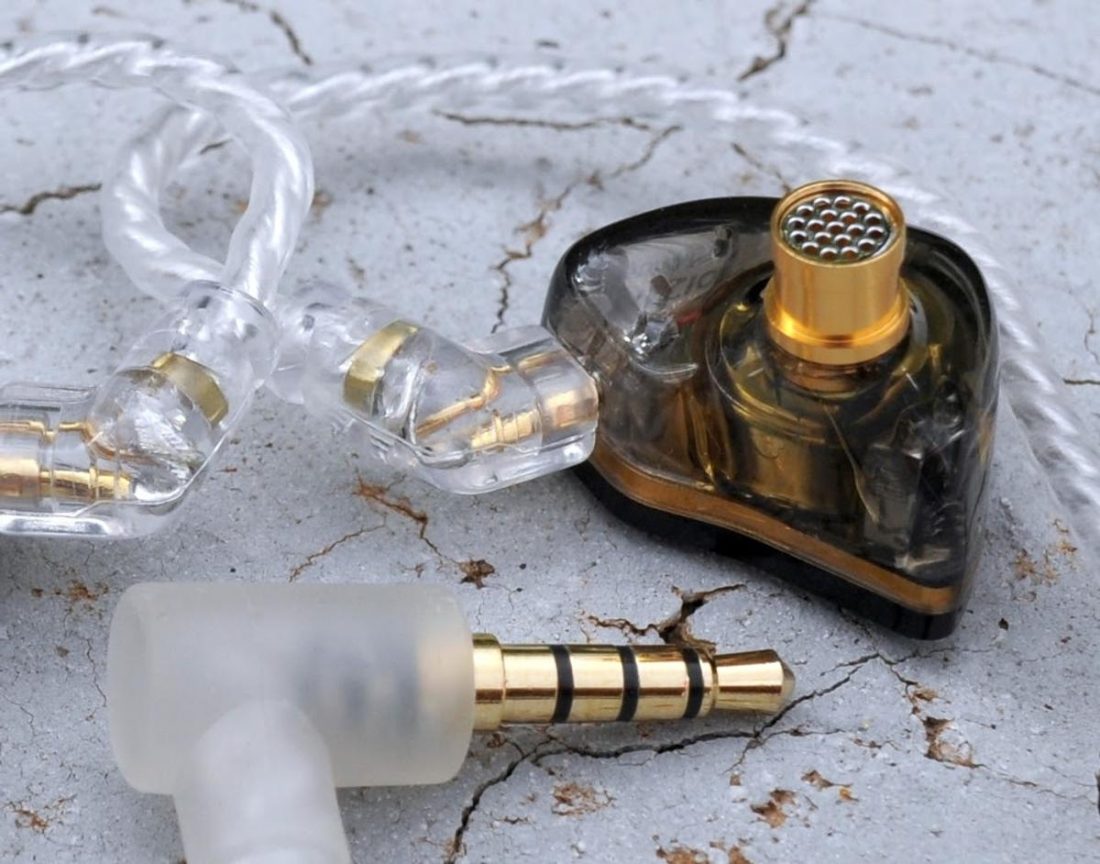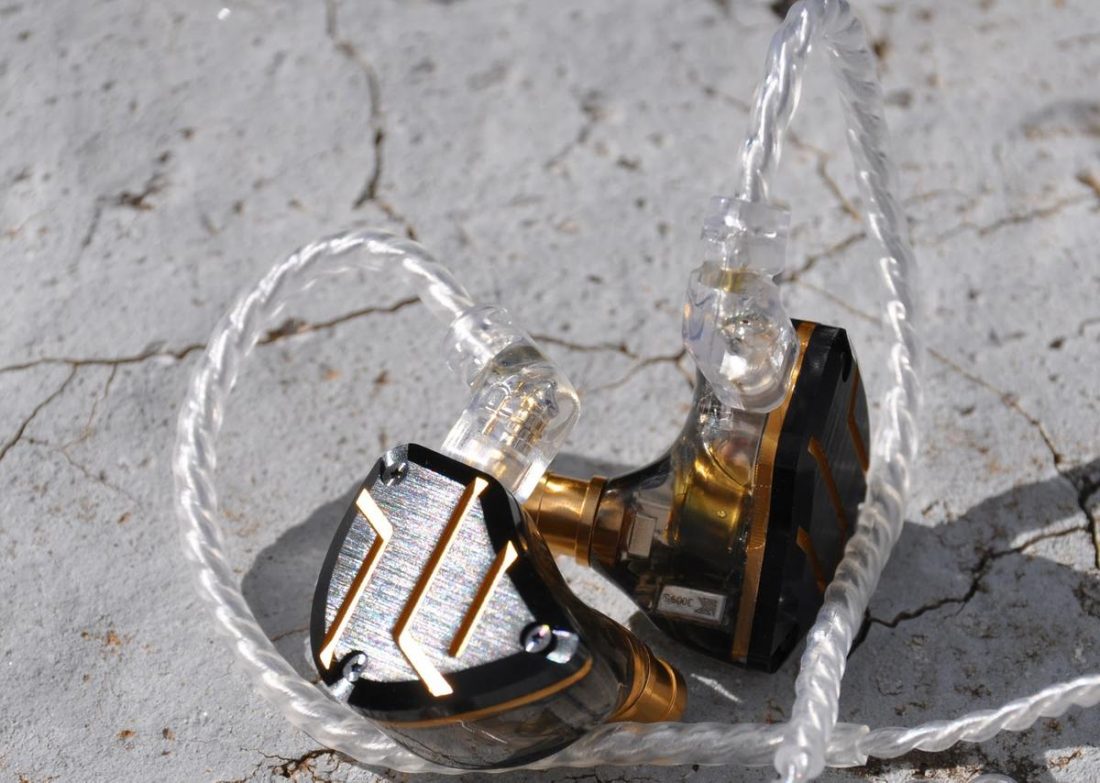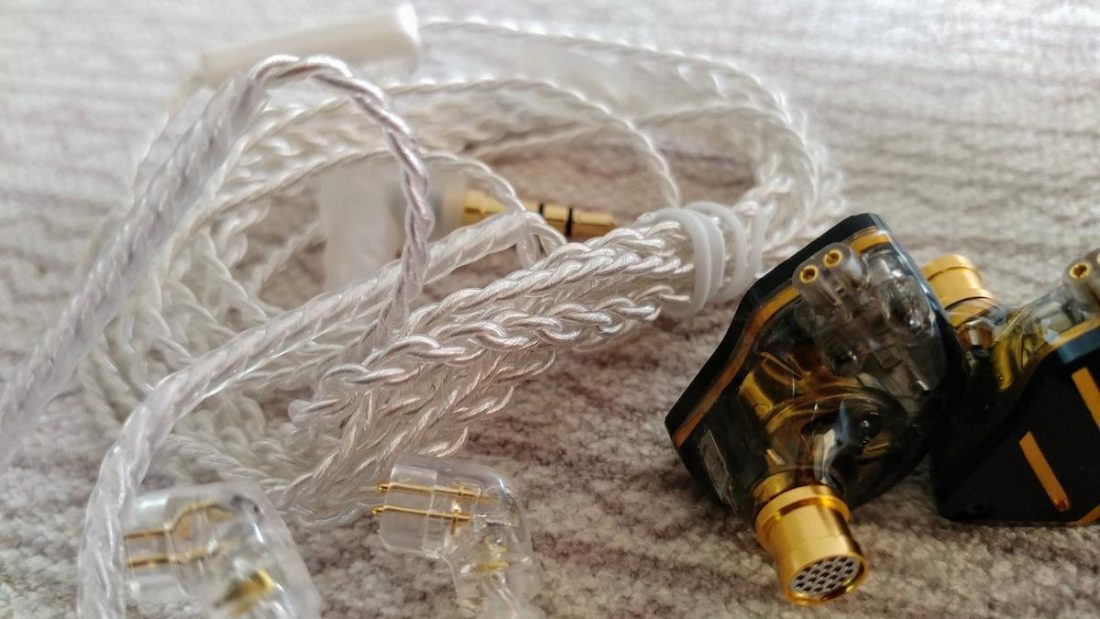The small plain white box I received with an embossed bold black CCA logo was humble and unassuming. What was hidden within was not. When I opened the box and witnessed the stunning black and gold faceplates, images of Egyptian Pharaohs’ and Queens’ tombs conjured in my mind. Ancient Egyptians believed that the Pharaohs, sons of the sun deity Ra, would rejoin the gods in the afterlife, and therefore have flesh of gold. The mummies’ were covered by masks and coffins, and surrounded by other heavily gilded precious worldly objects were predominantly made of gold. Why? These would protect the King’s body, still considered alive in the tomb, for eternity. If a Pharaoh or Queen would have chosen earphones, these very might have been them.
First Impressions
Visually, these C10 Pros are striking and clearly stand out from the crowd of IEMs. I wondered from their size if they may protrude a lot while wearing — this was not the case. They snuggle in well to the ear and proved to be secure and a good fit. I could not find a proper fit with the supplied ear tips. As expected, the result was less than the best of what these C10 Pros can offer. Fitting memory foam ear tips addressed this, though the tips are a bit challenging to swap quickly and easily.
Company Overview
Since its establishment in 2004, Shenzhen China-based CCA Innovation Technology Limited has focused on bringing innovative products to the global market in the field of consumer electronics. CCA emphasizes that quality has always been one of their key focus areas — from design, to development, to thorough testing for functionality and reliability prior to release.
Technical Specifications
Transducer Driver: 1DD+4BA Hybrid Driver Earphones — a single 10mm dual magnetic large dynamic driver and four balanced armatures (mid and high-frequency combination) Impedance: 24 Ohms Sensitivity: 109 db Frequency range: 20 Hz – 40 KHz Style: In-ear, with earhook cable Connector: 0.75mm 2 Pin Plug Type: 3.5mm L-shaped gold-plated plug Cable length and type: 1.25m, standard 100-core silver-plated
Packaging
Minimal packaging is greatly appreciated from a consumable/recyclable standpoint. The only plastic used was a light thin plastic film securing the box. Theoretically, this also means that the consumer is paying more for the product, and less for the wrapping. There is a stark contrast of packaging to the dramatic style of the earphones.
In the box
2 CCA C10 Pro IEMs 1 braided 0.75mm 2-pin standard 100-core silver-plated detachable cable with inline microphone (see next section below) 4 pairs of black silicone ear tips Printed instruction and information pamphlet that provides basic and minimal information
Cable
The lightweight standard 100-core silver-plated cable appears to be of excellent quality and performs well. The translucent plastic wishbone protective splitter feels sturdy. It has a 90° earplug design and a 3.5mm gold plated plug. The built-in microphone employs one-button push operation and feels solid with strong positive actuation. The cable itself is as beautiful as the IEM bodies. Under different light, the color seems to morph from white to a glimmering light silver. The braiding is entirely consistent and transmits zero noise when tapping or rubbing against anything. The ear hooks shape well around the ear without exerting pressure, are secure, and comfortable — it’s easy to forget that they are there.
Design
The textured aluminum alloy faceplates are unique in a sea of earphones that are physically bulbous, smooth, and oftentimes nondescript in every way. The faceplates are screwed down to secure them to the crystal resin IEM body, allowing a glimpse of the internals and impressive engineering. The C10 Pros are smooth where it counts, and still make virtually no contact with your ear when placed well. The edges are unnoticeable in the ear and the shape makes them easy to get a grip on to insert or adjust. From a purely design aesthetic, I wonder if it’s possible to make a matching black and gold cable an option for the future? The silicone ear tips do not easily come on and off, requiring some work and patience to secure them properly. The nozzle is long enough that I never felt the body of the IEM making any uncomfortable contact with my ear. When inserted properly, they look streamlined to the shape of the ear.
Comfort
The aluminum and resin body construction results in a very light package, despite that the IEMs are larger than many others. Suspended into the right position by the ear hooks, the weight is not noticeable and was never an issue despite hours of use. Noise isolation is excellent with the right seal. The cord is easy to forget as well. The ear hooks hold well and conform around the ear without exerting any bothersome pressure.
Internals
The CCA C10 Pros are 1DD+4BA Hybrid Drivers HIFI In-Ear Earphones (IEMs). The driver configuration includes one dynamic driver and four fine grinding balanced armatures, detailed here:
a single 10mm dual magnetic dynamic driver 30095 balanced armature for high frequency 50060 balanced armature for mid frequency customized balanced armatures
All together, they purportedly produce a wide transverse sound field, precise image positioning, and rich bass.
CCA C10 Pro Sound
For evaluation, I listened to a great variety of music from numerous sources. Using the provided silicone ear tips did not work well for me, prompting me to quickly switch to memory foam tips. With a very high sensitivity of 109db and a very low impedance of 24ohms, these IEMs are easy to drive with virtually any source. Vocals were generally clearer and more forward than instrumentation. These earphones are well suited for vocal jazz, R&B, new age, contemporary, pop, and rock music. In general, they are both bright enough to be interesting and smooth enough to be pleasing. Opera and highly dynamic classical music, a bit less so. Curiously, vocal performances with strong vibrato created some odd aural effects; the C10 Pros seemed to struggle to keep up with rapid dynamic fluctuations in sound. The sound was occasionally inconsistent and was dependent on the source and composition of the music. At times, musical passages that I expected to sparkle brightly did not — while not muddy, they were just slightly dulled and somewhat lackluster. I noticed in critical listening something that I can best describe as a sense that there is something missing in the separation of lower frequencies. While I do not have an official frequency response recording charted to verify, there sounds to be a slight dip between sub-bass/bass frequencies, and where these IEMs are strongest in the midrange. My theory: this may be due to a tuning/blending issue or continuity of perceived sound with all the different drivers. Channel separation was excellent and produced a fairly wide, above-average soundstage. Much of the time I would place the source of the sound as if it were produced a few inches away from my ears, as opposed to feeling as if the sound was in the center of my head.
Bass
Bass feels and sounds natural and appropriate when listening to well-recorded acoustic music and jazz; the Dynamic Driver performs well when the music has space. With very densely layered music and recordings with heavy presence of pressing and pervasive electronically generated sub-bass and bass frequencies (e.g., techno, deep house, club dance, etc.), it sounded to me that the earphones were overwhelmed; the IEM equivalent of bottoming out. Reproducing these sounds with any accuracy and impact was questionable.
Midrange
The CCA C10 Pros sound strongly midrange forward. Mid to mid-upper frequencies can be highly prominent and forward depending on the source. The tuning is most suited to modern jazz, acoustic recordings, and performances with vocal emphasis.
Treble
Treble smoothed out over time. The range of drivers may be the contributing factor to lively treble, resulting in a bright and clear reproduction. On occasion, the treble seemed to overshadow some of the breadth of the midrange, though not so much as to overpower lower frequencies.
Microphone performance
The C10 Pro version I tested had a microphone with a one-button/function control. The button has positive actuation and will be difficult to activate by accident. While testing with both mobile phones and a computer using video chat, clarity and sensitivity was excellent and clear, both receiving and transmitting.
Conclusion
It is important to note again that these IEMs require a significant burn-in period — they improved over time and performed better with more use. It’s also critical that you find a proper fit and seal to bring forward the best that these IEMs can offer. As I often state, I also believe that many buyers will greatly appreciate the inclusion of memory foam tips in addition to the silicone set provided, or an increased diversity of tips. These uniquely attractive and affordable IEMs will be a go-to everyday pair for many who appreciate a variety of music and sound, and prefer earphones that are more accurate and true to original recordings in their sound reproduction.
